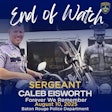SWAT teams have been part of the capabilities of police agencies since 1967 when the Los Angeles Police Department organized its special weapons and tactics unit to respond to critical incidents. Since then, the number of SWAT teams has increased dramatically nationwide. California alone now has more than 180 police tactical teams.
The explosive growth of SWAT teams can actually be traced to the U.S. military's reduction-in-force program following the end of the Cold War. That program resulted in numerous donations of military surplus equipment to police agencies in the 1990s. Likewise, a cottage industry of former military and law enforcement officials grew up to provide tactical training to special police units at an affordable cost. The ready availability of equipment and training for tactical law enforcement teams has allowed even the smallest agency to deploy a SWAT unit or contribute officers and resources to a regional SWAT team.
Some agencies have decided SWAT teams must be used as often as possible to justify the expense of having them. These policies have led to some problems that have resulted in legal action. While well-trained SWAT teams can reduce exposure to injuries for civilians and officers alike, many teams operate without adequate training and that leaves them vulnerable to litigation.
Recently, two highly publicized wrongful death cases involving SWAT teams in California spurred state Attorney General Bill Lockyer to form a broad-based commission to study SWAT operations. The Commission members included law enforcement executives (many with tactical team experience), concerned citizens from a broad range of interests and backgrounds, attorneys from both public agencies and private firms, and representatives from various public interest groups.
The SWAT Commission, officially formed in April 2001, was tasked with assessing the level of tactical capability in California and making recommendations to the attorney general regarding improvements to the system. To achieve this goal, the commission formed four subcommittees-tactics, training, policy and equipment, and risk management-to review tactical operations.
In its final report, which was published last September, the Commission made several recommendations that apply not only to teams in California, but can also serve as a model of how to operate and manage a tactical team for agencies nationwide.
The SWAT Commission developed seven recommendations for the Attorney General, which have since been adopted. These recommendations serve as a blueprint for law enforcement agencies on how to improve and manage their tactical teams.
Defining SWAT
One of the most interesting conclusions of the commission was that there is no agreed upon definition as to what constitutes a SWAT team.
The survey results received by the SWAT Commission demonstrated that law enforcement agencies throughout the state fielded SWAT units. However, there was a wide variance in terms of time devoted to training, the nature of the units associated with the duty, i.e. full-time or part-time, and the names given to such units.
After analyzing the results of its survey, the Commission concluded that it was important to develop a definition of a "SWAT Team." The following definition was approved: "A SWAT team is a designated unit of law enforcement officers who are specifically trained and equipped to work as a coordinated team to respond to critical incidents, including, but not limited to, hostage taking, barricaded suspects, snipers, terrorist acts and other high-risk incidents. As a matter of agency policy, such a unit may be used to serve high-risk warrants, both search and arrest, where public and officer safety issues compel the use of such a unit."
Team Quality
Another somewhat startling conclusion of the Commission was that there were no set standards for SWAT teams in California. After much debate, the commission developed a matrix defining various levels of team capability.
Level One is a basic team capable of providing containment and intervention for critical incidents beyond the training and resources available to line officers. This does not include ad hoc teams of officers that are formed around a specific mission, detail or incident, for example, active-shooter response. Generally, 5 percent of the basic team's on-duty time should be devoted to training.
Level Two is an intermediate team capable of providing containment and intervention that possesses tactical capabilities above the Level One teams. These teams may or may not work together on a daily basis, but are intended to respond to incidents as a team. At least 5 percent of their on-duty time should be devoted to training.
Level Three is a full-time tactical unit whose members spend 25 percent of their on-duty time in SWAT training. These teams operate in accordance with contemporary best practices (such as the suggested SWAT best practices advocated by the National Tactical Officers Association). They possess both skills and equipment to utilize tactics beyond the capabilities of Level One and Level Two teams.[PAGEBREAK]
Training Standards
Another concern that was addressed by the Commission was the need for mandated training standards for SWAT teams in California agencies.
The Commission recognized immediately that there was a wide variance among agencies in terms of SWAT training. Formal training was found to be offered throughout the state by both private organizations and public agencies. It was noted that the California Peace Officers Standard and Training Commission (POST) did not establish any training standards in connection with SWAT operations and had no mandate to do so.
To address this issue, the Commission made the following recommendations:
- SWAT Teams should provide on-duty training in accordance with their mission.
- POST should continue to develop and certify contemporary curricula for all basic and advanced SWAT training.
- SWAT personnel (excluding support) should participate in POST-certified basic and advanced SWAT training. New SWAT Team members should not be deployed in operational functions without having first completed POST-certified basic training.
- In-service SWAT training should be relevant to SWAT missions, as defined in agency policy. Such policy should address individual team members' responsibilities, performance-related skills, use of force, and command and control functions. Training should be performance based and ensure that individual team members maintain physical and operational competencies.
- SWAT training "needs assessments" should be conducted annually by each agency to ensure that training matches agency policy
- SWAT training must include lesson plans and records of attendance that should be retained pursuant to agency policy.
- SWAT personnel, team administrators, and potential incident commanders should receive training regarding SWAT mission assessment, deployment criteria, operational training, incident command, multijurisdictional protocols, decision making, tactical options, and communications and accountability.
- SWAT training, including firearms training, should incorporate established written safety protocols and on-site safety officers.
- SWAT Teams should regularly participate in scenario-based training to
include all relevant agency crisis intervention components such as field command, patrol, traffic, hostage negotiations, canine, and bomb technicians, as well as outside agency responders, including fire, EMS, and allied law enforcement agencies.
SWAT Deployment
The Commission found a lack of uniformity in tactical utilization of SWAT teams. Some agencies utilized their teams to execute all search warrants related to narcotics. Others called their teams out only in cases of hostage-taking situations, high-risk arrest warrants, and similar operations. Widely disparate techniques were noted in the execution of SWAT operations, including dynamic entry and surround and call-out tactics. The utilization of SWAT for "knock and notice" operations was also discussed.
The Commission made the following recommendations:
- Time permitting, an operational plan for responding to each incident should be prepared.
- Generic checklists should be developed to be worked through prior to initiating a tactical action.
- Standard methods for determining whether or not a warrant should be regarded as high risk should be developed.
- A method for deciding how to best serve a high-risk warrant with alternatives being reviewed in accordance with risk-benefit criteria should be developed prior to selecting the method of response.
- Written officer-involved shooting policies applicable to SWAT operations should be developed.
- There should be a debriefing after every deployment of a SWAT Team for the purposes of improving future performance.
- Departments should develop sound risk-management analysis when dealing with tactical teams.
- The presence of legal counsel when appropriate should be discussed.
- There should be a standardization of equipment deployed by tactical teams.
California appears to be the first state to take a close, hard look at the operation of tactical teams. Consequently, the SWAT Commission's Final Report should be used as a model by police departments nationwide on how to organize and develop their tactical teams. It is also important to note that those attorneys who sue police departments are likely to use this report to attack SWAT teams in future litigation. Thus, it is incumbent upon each department to evaluate its tactical team according to the recommendations of this report, and to determine that the team is being appropriately used and supervised.
Eugene P. Ramirez is a founding member of Manning & Marder, Kass, Ellrod, Ramirez, LLP. He is an instructor for the Los Angeles County Sheriff's Department's Basic SWAT Schools, legal Advisor for the National Tactical Officers' Association (NTOA), and a member of the California Attorney General's SWAT Commission.

















